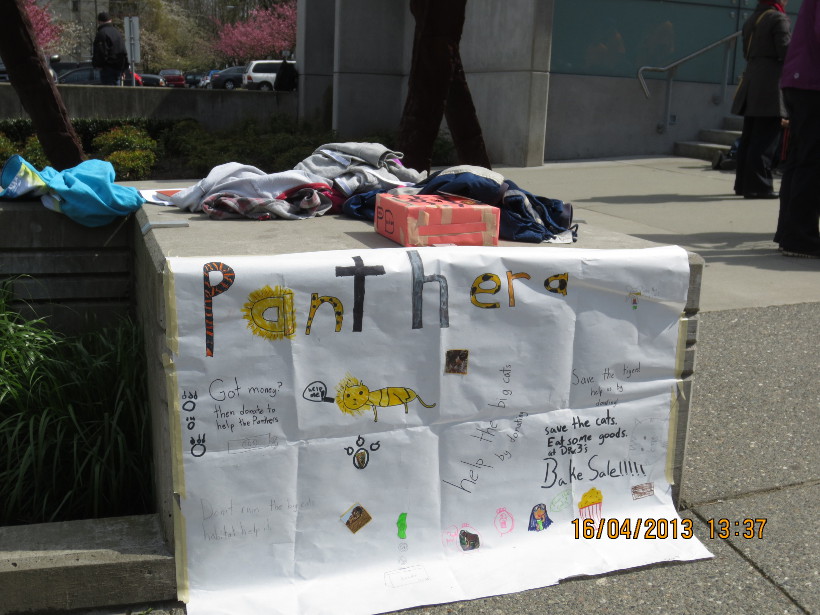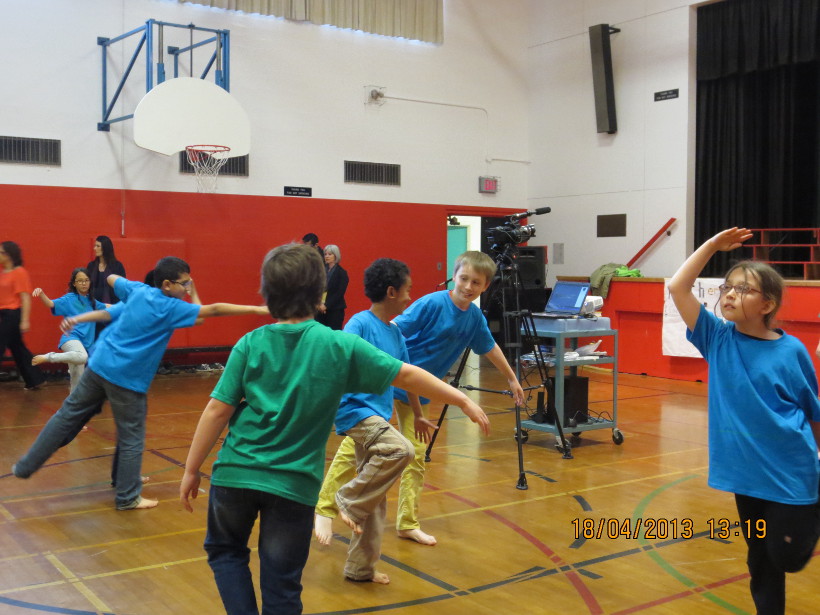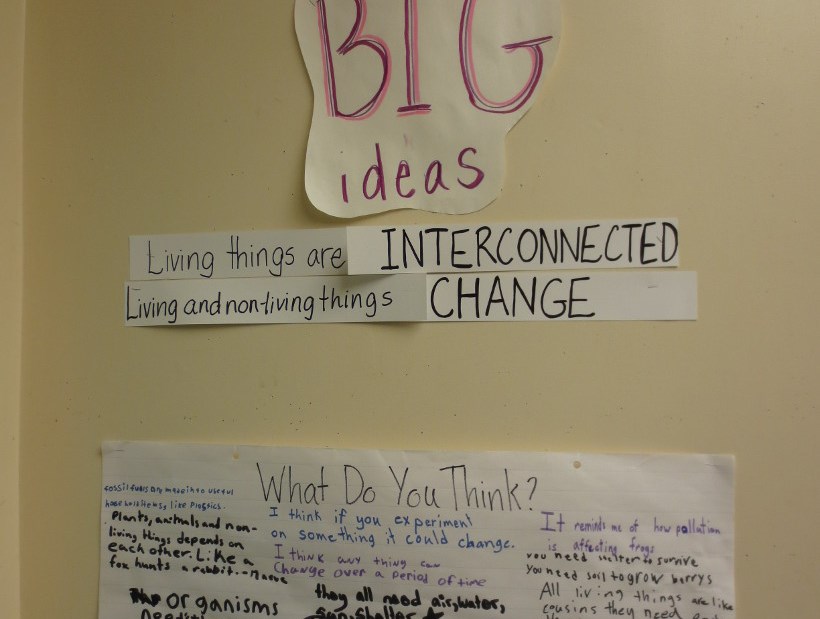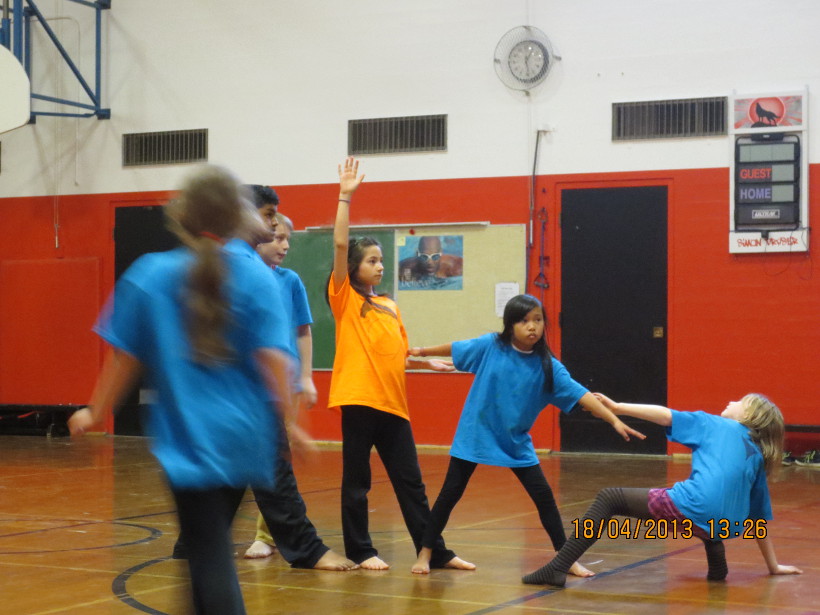Simon Fraser Gr 4/5
Arts Education, Language Arts, Science
School:
Simon Fraser Elementary, Vancouver, BC
Teacher:
Teresa Kerr
Artists:
Lorraine White-Wilkinson, Laurel Martman
Class:
Grade 4/5
Sources of Inspiration:
Vancouver Biennale Legacy: Walking Figures
BBC Series: Planet Earth
Overview:
Students inquired into the BIG IDEAS of Interconnectedness in the study of habitats and communities through building visual web of connections, food chain mobile, public art visit and dance movements. The students reflected on how each and every part is important to the whole in all community and teamwork. As students inquired into their social responsibility to the environment, they took action to fundraise and support Panthera to save endangered animal species.
BIG IDEAS:
Interconnectedness in habitats
Guiding Question:
How are living and non-living things connected? What causes changes? Are we playing a socially and environmentally responsible role?
Curriculum Access:
Science, Language Arts, Arts Education – Dance, Mathematics
Learning Process:
The BIG IDEAS project provided the students at Simon Fraser Elementary a cross-curricular learning in habitats and communities, language arts/poetry and dance. The dance compositions extend the classroom learning of the food chain and concepts of interconnectedness. Students learnt to reflect and form connections on the multiple channels of learning.
Student Creations:
Descriptive words were gathered during the fieldtrip to the Walking Figures and organized into a chart. Working in groups, students wrote short poems using selected words which were then put together for edit by the class. The created poem was read by a student to introduce their three dance performances: at the Walking Figures, during school assembly and at the Vancouver School Board Dance Celebration at Van Tech.
Taking Action:
The students initiated a fundraising effort to support a global non-profit organization to save endangered species.
Timeline:
Jan
- Prep: Introduced to Vancouver Biennale BIG IDEAS program and the Walking Figures. Shared and recorded thoughts and reactions. Shared and recorded big ideas in class.
- Create a big ideas wall to record thoughts throughout the project.
- Shared insights: Reflected on what a habitat is and what the environment is? Watched the BBC series Planet Earth. Identified different habitats and discussed what living things need to survive
- Introduction to Body and Dance: learnt about personal space and general space through dance. Created group shape and decision making. Relate to the shape of the Walking Figures.
Feb
- Science Vocabulary: Learnt to use words like habitat, environment, niche and organism. Identified what are critical items for survival: food, water, shelter and appropriate temperature.
- Team Expression through Dance: Worked on living fence linking to the guiding question of connectivity. Discussed shape and pattern.
- Field trip to the Walking Figures: Observed and completed a five senses graphic organizer, writing down descriptive words related to the senses. Sketched the sculptures from different perspectives.
- Dance, Words and Shapes: Reflected on field trip and expressed ideas through formation of shapes. Explored association of shapes with words. Practiced the formation of living fence and connectedness.
- Visual Web of Connections Challenge: Each student picked a card with an image and information about a living or nonliving thing. A ball of yarn is passed from student to student to create the visual web. Everyone takes turn to talk about how their living or nonliving thing is connected to another student’s living or nonliving thing. Students wrote about the connections after the activity and a summary was posted on the big ideas wall.
- Reading and Listening: High Interest Aboriginal Theme Book Strategies: Langley School District.
- Chief Seattle How Can You Buy the Sky? How Can You Own the Rain and the Wind?
- Discussed how humans impact the environment. Students Listened to the Read Aloud The Elders are Watching by David Bouchard and Illustrated by Roy Henry Vickers.
- Group discussion on the relationship between First Nations people and the environment.
- Created group poems which turned into a class poem.
- Research on help and competition in habitats as well as natural and human dangers to habitats
Mar
- Reading and Vocabulary: Listen to Pass the Energy Please by Barbara Shaw McKinney and learnt and used food chain vocabulary
- Food Chain Mobile Challenge: using pictures of organisms from a forest habitat, construct a food chain mobile.
- Big ideas Reflection: Working in pairs to connect the big ideas and the Walking Figures. Summarized on the wall.
- Dance Sessions: Began work on choreography in groups and develop the group waves as a form of energy transferral
- Dance/Art/Science Reflection: Drew images of their dancing experience. Reflected and wrote how dance movement connects with the Walking Figures and interconnectedness among living and nonliving things.
Apr
- Performance Practice and Rehearsal
- Reviewed and rehearsed in school and at the Walking Figures
- Fundraised for the non-profit organization Panthera to save endangered species due to destruction of habitats.
- Three performances
May
- Wrote reflection on learning experience
Reflections:
Artist(s):
Lorraine White-Wilkinson: This collaborative project was extremely successful, due to the openness and willingness of all the collaborators involved. Working with Laurel Martman as an assistant was a valuable experience for me in that our conversations provided moments of clarity in regards to both my teaching style, as well as the pathway we were leading the students along. The classroom teacher was supportive and patient with the process, and so willing to lend her time and that of the student’s for this project. A belief and commitment from the teacher has proven to be a truly magical ingredient in this project. The students were enthusiastic as well as courageous, and we were happy to be able to provide them with three opportunities to share their dance as well as their poetry and explanation of the process, linking it to their science unit and their cause (Panthera). Although our project was linked to the science curriculum, it was amazing at how cross curricular links represented themselves. Students took their cause to another level by even having a class bake sale in support for Panthera!
Laurel Martman: As a dance student at SFU, I was lucky to be part of Vancouver Biennale’s Teacher-Artist Collaboration. My internship provided me with an insight into instructing dance within the school system using movement and creative thinking to ‘experience’ curriculum. Over the course of 19 sessions, we practiced a physical approach to learning that demonstrated to me the value of exploring concepts (which began in science class) further through dance exercises.
We considered themes from science from a different angle by giving attention to curricular themes that informed how we moved – how we used time, space, weight and tension to develop an extended exploration of a topic. Our dance compositions were an extension of their learning in the classroom about the food chain and concepts of interconnectedness. Reflecting and forming connections were an important part of bridging material. Themes we explored linked up with each other like a web. The students found these connections by themselves.
Using dance to explore curriculum led to an understanding that was embodied, and appealed especially to predominant kinesthetic learners. Reflecting on how their dancing and their science lessons were connected broadened and deepened students’ understanding of the topics. I am leaving this internship with a sparked interest in how I might use movement as an instructional tool in the future.
Students:
On what they learnt from the Walking Figures:
- The Walking Figures show how we are connected (they are a tribe)
- The figures are the same but different
- It inspires a group poem that brought all of us thinking collectively
How does the Walking Figures and the dance experience connect with the science lessons and the study of food chain?
- Concept of everything being interconnected – change in one part affects the whole
- If one part is removed it won’t be the same
- Likewise, everything and everyone is important to the dance as it is now – it takes each one of us to make it what it is
- Things change…in life and in our dance: living and non-living things change; our dance transformed/evolved as we worked on it
What were the key learning from the performance?
- We tried harder when there was an audience
- Having spectators made us feel energized
- In the performance, the wave did not go as we had practiced it – we had to adapt/resolve in the moment
What do you think was the best part of this whole experience?
- Performing
- The section of choreography where we dance our group poem
- Doing the wave and the living fence
- Helping Panthera/bake sale
- Writing a poem and turning it into dance
- Learning about the Walking Figures
- The site specific performance for community/passersby
- Being interviewed
- Introducing the show (said the student who did this)
- The feeling right after the first performance
- Our teachers!
Related Material
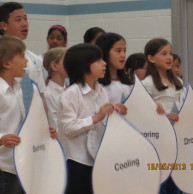 BIG IDEAS in Science and Technology
BIG IDEAS in Science and Technology